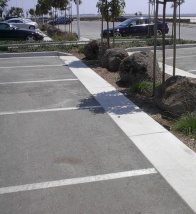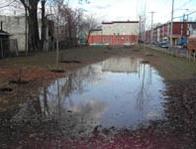Water: Polluted Runoff
Managing Urban Runoff
You will need Adobe Reader to view some of the files on this page. See EPA's PDF page to learn more.
Fact Sheets | Guidance Documents & Manuals | Information Resources & Centers | Research Facilities | Research Studies
Urban Runoff Quick Links
- Learn about Low Impact Development (LID)
- Learn about Smart Growth
- Managing Urban Runoff for Homeowners
- Controlling Impacts from New Development
- Controlling Impacts from Existing Development
- National Management Measures for Urban Runoff (Guidance)
- EPA Research on Urban Watershed Management
- Model Ordinances
Explore Polluted Runoff
(Nonpoint Source Pollution)
NPS Categories

Infiltration islands in a parking lot in San Mateo, California, help reduce runoff. (Photo courtesy of John Kosco)

New homes replace farmland in Dallas County, Iowa, as suburbs of Clive and Waukee grow on the west side of Des Moines. (Photo courtesy of NRCS)

This vacant lot in Philadelphia was regraded to direct runoff into strategically placed swales and depressions. (Photo courtesy of Philadelphia Water Department)
Urbanization increases the variety and amount of pollutants carried into our nation's waters. In urban and suburban areas, much of the land surface is covered by buildings, pavement and compacted landscapes with impaired drainage. These surfaces do not allow rain and snow melt to soak into the ground which greatly increases the volume and velocity of stormwater runoff. In addition to these habitat-destroying impacts, pollutants from urban runoff include:
- Sediment
- Oil, grease and toxic chemicals from motor vehicles
- Pesticides and nutrients from lawns and gardens
- Viruses, bacteria and nutrients from pet waste and failing septic systems
- Road salts
- Heavy metals from roof shingles, motor vehicles and other sources
- Thermal pollution from dark impervious surfaces such as streets and rooftops
These pollutants can harm fish and wildlife populations, kill native vegetation, foul drinking water, and make recreational areas unsafe and unpleasant.
Fact Sheets
- Protecting Water Quality from Urban Runoff
This is an EPA fact sheet about how urban runoff affects water quality (February 2003, EPA 841-F-03-003). - Nonpoint Pointer No. 7 - Managing Urban Runoff
This is an EPA fact sheet from 1996 (EPA 841-F-96-004G).
Guidance Documents and Manuals
- National Management Measures to Control Nonpoint Source Pollution from Urban Areas
This guidance helps citizens and municipalities in urban areas protect bodies of water from polluted runoff that can result from everyday activities. These scientifically sound techniques are the best practices known today. The guidance also helps states to implement their nonpoint source control programs and helps municipalities implement their Phase II Storm Water Permit Programs (November 2005, EPA 841-B-05-0004). -
Rainwater Harvesting: Conservation, Credit, Codes, and Cost Literature Review and Case Studies (PDF) (41 pp, 517K)
This technical guidance document describes emerging practices involving rainwater harvesting. These practices have the potential to supplement water supplies, manage stormwater and provide a number of additional environmental benefits. This document will be of interest to water utility planners and engineers, municipal public works planners and engineers, and non-governmental organizations interested in promoting water reuse. (January 2013, EPA-841-R-13-002) - Economic Benefits of Runoff Controls
The purpose of this report is to show that certain urban runoff management controls can be incorporated into a development in a way that provides aesthetic and economic benefits (September 1995, EPA 841-S-95-002). - Management Measures for Urban Areas
This is the urban management measures chapter in the official and operative guidance authorized by Congress under Section 6217(g) of the Coastal Zone Act Reauthorization Amendments of 1990. - Model Ordinances to Protect Local Resources
These pages include model ordinances to serve as a template for those charged with making decisions concerning growth and environmental protection. - Urban Runoff Management Documents
This is a list of documents on managing urban runoff that the Nonpoint Source Control Branch at EPA headquarters has found to be especially well done. - Techniques for Tracking, Evaluating, and Reporting the Implementation of Nonpoint Source Control Measures - Urban
This guidance is intended to assist federal, state, regional and local environmental professionals in tracking the implementation of best management practices (BMPs) used to control urban nonpoint source pollution (January 2001, EPA 841-B-00-007). - Onsite Wastewater Treatment Systems Manual (PDF) (367 pp, 20.9MB)
This manual provides current information on onsite wastewater treatment system (OWTS) siting, design, installation, maintenance and replacement. It reflects significant advances that the expert community has identified to help OWTSs become more cost-effective and environmentally protective, particularly in small suburban and rural areas (February 2002, EPA 625-R-00-008). - Financing Stormwater Management

This site includes an annotated bibliography of existing stormwater finance materials; an archive that contains selected previously published materials concerning stormwater finance; a manual that discusses the financing options available to communities for stormwater management programs. - Guidance for Municipal Stormwater Funding (PDF) (140 pp, 612K)
Developed in January 2006, this guidance examines a range of possible approaches to paying for stormwater management, with a focus on developing guidelines for service/user/utility fees to support these programs.
Information Resources and Centers
- Center for Watershed Protection

The Center for Watershed Protection works with local, state and federal governmental agencies, environmental consulting firms, watershed organizations and the general public to provide objective and scientifically sound information on effective techniques to protect and restore urban watersheds. - Stormwater Manager's Resource Center

The Stormwater Manager's Resource Center (SMRC) is designed specifically for stormwater practitioners, local government officials and others that need technical assistance on stormwater management issues. - EPA Smart Growth
This site provides information to help create communities that promote the sustainability of America's environment, economy and quality of life. - Low Impact Development (LID)
Learn from reports, studies and documents about the effectiveness of LID practices, and access manuals and tools for implementing Low Impact Development. - National Conference on Urban Stormwater: Enhancing Programs at the Local Level (2003)
A wide array of effective storm water management and resource protection tools have been developed for urban environments, but their implementation continues to be hampered by a lack of technology transfer opportunities. At the national conference Urban Stormwater: Enhancing Programs at the Local Level (February 17-20, 2003), attendees learned about state-of-the-art technologies and implementation programs that have proven success in local communities. This page provides papers from that conference. - American Society of Civil Engineers

The ASCE provides a variety of resources to both members and non-members. Visit this site to learn more about upcoming events, current issues and membership opportunities. - American Water Resources Association

The American Water Resources Association is a non-profit professional association dedicated to the advancement of men and women in water resources management, research and education. - Florida Stormwater Association

The Florida Stormwater Association is composed of local governments, consulting firms, water management districts, water control districts and some non-profit organizations. These members have joined together to enhance the capacity of stormwater management through research, dissemination of information, active participation in the legislative decision process, and education. - International Stormwater Best Management Practices (BMP) Database

This database provides access to stormwater BMP performance data in a standardized format for over 170 BMP studies conducted over the past fifteen years. The database was developed by the Urban Water Resources Research Council (UWRRC) of ASCE under a cooperative agreement with the US Environmental Protection Agency. - RiverSides Stewardship Alliance

RiverSides is a non-profit organization dedicated to creating RiverSafe communities—communities that protect rivers by reducing runoff pollution from individual properties through education and providing the tools people need to make the connection between personal action and healthy rivers. - Urban and Coastal Community Conservation Resources

The National Association of Conservation Districts provide urban and community conservation resources and give conservation districts and their partners a place to gather information and exchange ideas about their urban and community conservation activities. - Financing Stormwater Management

This site was developed by the Center for Urban Policy and the Environment at Indiana University-Purdue University Indianapolis (IUPUI) in cooperation with the Watershed Management Institute, Inc. Funding was provided by the EPA. The site includes an annotated bibliography of existing stormwater finance materials; an archive that contains selected previously published materials concerning stormwater finance; a manual that discusses the financing options available to communities for stormwater management programs; a set of case studies that describe successful finance mechanisms that have been used in seven communities around the country; and a group of links to other useful web sites about stormwater management. - How to Create a Stormwater Utility (PDF) (125 pp, 2.9MB)

This is a set of documents placed into a single PDF file that describes the various steps necessary to create an effective stormwater utility. The document was created by the towns of Chicopee and South Hadley, Massachusetts using Section 319 grant funds.
Research Facilities
- EPA's Urban Watershed Research Facility
EPA's Urban Watershed Research Facility (UWRF), located in Edison, New Jersey, is a 20-acre, isolated, open space designed for the research of technology that may be used to control or mitigate stormwater runoff. - EPA's Water Quality Research
This EPA group researches, develops and demonstrates technologies, systems and methods to manage the risks to public health, property and the environment from aquatic ecosystem stressors.
Research Studies
- Urban Stormwater Best Management Practices Study
This EPA report from 1999 summarizes then-current information and data regarding the effectiveness of BMPs to control and reduce pollutants in urban stormwater, as well as their expected costs and environmental benefits (August 1999, EPA 821-R-99-012). - Urban Stormwater BMP Performance Monitoring
This EPA manual from 2002 provides targeted practical assistance in conducting water quality monitoring and reporting data that are useful for assessing the effectiveness of stormwater BMPs (April 2002, EPA 821-B-02-001).
